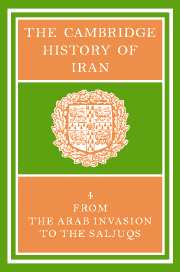Book contents
- Frontmatter
- 1 THE ARAB CONQUEST OF IRAN AND ITS AFTERMATH
- 2 THE ‘ABBĀSID CALIPHATE IN IRAN
- 3 THE ṬĀHIRIDS AND ṢAFFĀRIDS
- 4 The SĀMĀNIDS
- 5 THE EARLY GHAZNAVIDS
- 6 THE MINOR DYNASTIES OF NORTHERN IRAN
- 7 IRAN UNDER THE BŪYIDS
- 8 TRIBES, CITIES AND SOCIAL ORGANIZATION
- 9 THE VISUAL ARTS
- 10 NUMISMATICS
- 11 THE EXACT SCIENCES
- 12 LIFE SCIENCES, ALCHEMY AND MEDICINE
- 13(a) PHILOSOPHY AND COSMOLOGY
- (b) SŪFISM
- 14 THE RELIGIOUS SCIENCES
- 15 SECTS AND HERESIES
- 16 NĀSIR-I KHUSRAU AND IRANIAN ISMĀ‘ĪLĪSM
- 17 ZOROASTRIAN LITERATURE AFTER THE MUSLIM CONQUEST
- 18 ARABIC LITERATURE IN IRAN
- 19 THE RISE OF THE NEW PERSIAN LANGUAGE
- 20 (a) THE “RUBĀ'Ī” IN EARLY PERSIAN LITERATURE
- (b) ‘UMAR KHAYYĀM: ASTRONOMER, MATHEMATICIAN AND POET
- Bibliography
- Index
- Plate section
- Plate section">
- Map 1. Iran under the Abbasids">
20 (a) - THE “RUBĀ'Ī” IN EARLY PERSIAN LITERATURE
Published online by Cambridge University Press: 28 March 2008
- Frontmatter
- 1 THE ARAB CONQUEST OF IRAN AND ITS AFTERMATH
- 2 THE ‘ABBĀSID CALIPHATE IN IRAN
- 3 THE ṬĀHIRIDS AND ṢAFFĀRIDS
- 4 The SĀMĀNIDS
- 5 THE EARLY GHAZNAVIDS
- 6 THE MINOR DYNASTIES OF NORTHERN IRAN
- 7 IRAN UNDER THE BŪYIDS
- 8 TRIBES, CITIES AND SOCIAL ORGANIZATION
- 9 THE VISUAL ARTS
- 10 NUMISMATICS
- 11 THE EXACT SCIENCES
- 12 LIFE SCIENCES, ALCHEMY AND MEDICINE
- 13(a) PHILOSOPHY AND COSMOLOGY
- (b) SŪFISM
- 14 THE RELIGIOUS SCIENCES
- 15 SECTS AND HERESIES
- 16 NĀSIR-I KHUSRAU AND IRANIAN ISMĀ‘ĪLĪSM
- 17 ZOROASTRIAN LITERATURE AFTER THE MUSLIM CONQUEST
- 18 ARABIC LITERATURE IN IRAN
- 19 THE RISE OF THE NEW PERSIAN LANGUAGE
- 20 (a) THE “RUBĀ'Ī” IN EARLY PERSIAN LITERATURE
- (b) ‘UMAR KHAYYĀM: ASTRONOMER, MATHEMATICIAN AND POET
- Bibliography
- Index
- Plate section
- Plate section">
- Map 1. Iran under the Abbasids">
Summary
In the western conception of Persian literature the words rubā‘īyāt and ‘Umar Khayyām have become practically synonymous, and it is only recently that scholarship in this field has brought a growing realization that this picture is incomplete. Before then we can consider to what extent Khayyām contributed to the development of this particular Persian literary form, we must go back a few centuries.
We need not concern ourselves here with the argument whether the classical Persian metres derive from Persian or Arabic sources; the one metre whose purely Persian origin has never been challenged is the rubā‘ī. The arguments in favour of a Central Asian, Turkic origin for the rubā‘ī put forward by Bausani are by no means to be dismissed, in spite of some rather dubious assumptions; but they have no bearing on the question of the metrical pattern, which is quite common in Persian but unknown elsewhere. Tradition indeed claims that it was invented by the early 4th/10th century poet Rūdakī. According to Shams-i Qais, writing in the 7th/13th century, Rūdakī (or some other poet) overheard the excited cry of a small boy (said by the 9th/15 th century biographer Daulatshāh to have been the son of Ya‘qūb b. Laith) as he was rolling nuts into a ditch:
ghaltān ghaltān hamīravad tā bun-I gav
Rolling along it goes to the edge of the ditch
Inspired by the balanced rhythm of this sentence, the poet went home and proceeded to write quatrains in this and equivalent metres, which in due course came to be known as rubā‘ī (four-line poem), dūbaitī (two-couplet poem), or tarāna (poem of freshness and youth).
- Type
- Chapter
- Information
- The Cambridge History of Iran , pp. 633 - 657Publisher: Cambridge University PressPrint publication year: 1975
- 2
- Cited by

